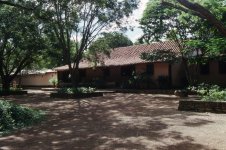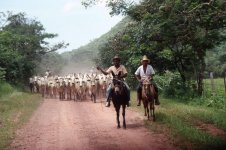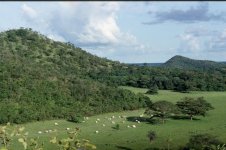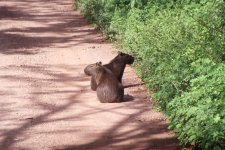about Hato Piñero and Hato El Cedral
Good afternoon!
Apologies for the long posting.
I have read with great interest the comments about the ranches in Venezuela and specially about the current situation of Hato Piñero and Hato El Cedral. Since the comments and worries cover a great deal of topics I am listing my contribution in the hope to bring a better understanding of the current situation of Hato El Cedral and the proposed actions. I intend to do the same for Hato Piñero and post it over the next week.
HATO EL CEDRAL
1. History.
This ranch was part of a huge ranch back in the 20’s named La Fuentera which covered almost a fourth of the state of Apure. Later, it was purchased by the King Ranch (back in the late 60’s. Date not accurate) and operated for few decades until they sold it to a corporation owned by a Venezuelan bank (This was between the late 70’s and the early 80’s). During this period is when the dikes and bridges were built allowing water storage during the peak of the dry season (Reason for huge concentration of waterbirds). That bank (Banco de Maracaibo) sold the ranch to another bank (Banco Progreso) in the early 90’s. Following a finnancial crisis in the mid 90’s and a huge bank collapse in Venezuela the government took control of the ranch as it was given as a guaranteed for a bank finnancial assistance program launched to fight the bank crisis. Later, in the late 90’s the ranch passed again hands to a cattle operating firm based in Venezuela. In order to be able to buy the ranch the firm got a loan from a local bank and such credit became difficult to pay as the cattle business became unviable due to price regulations defined by the early years of the Chavez administration. Although the ranch was never in fact in the scope of the government the owners decided to start talks about the possibilities to sale part of it to them. Such agreement became effective in 2008 when the government bought between 80-90% of the ranch and left about 10-20% of the share to the cattle firm. Fortunately the deal involved the whole ranch as an unit not parts of it. In review, for the last 80 years the ranch has passed ownership 7 times and it has always been run with a corporate vision rather than a family vision (case of Hato Piñero). During these years the ranch has passed under various management plans and in all of it there was always the hope to turn some of the wetlands into huge rice fields and the wild grasses into large pasture areas. None took effect due to lack of cash flow, until now.
2. Tour facilities.
I have been working with the ranch since 1985 when the tourism facilities were built for visitors. The ranch opened with 8 rooms, and today it has 27 rooms. In those days the argument used to convinced the owner to open a tour department was because they were in need of US$ to import cattle semen for artificial insemination. In those days we were under an exchange control so accessing to US$ via the commercial banks was forbidden (This has happened in Venezuela in various times for long periods and we are currently under a very tied exchange control). To give an idea about the profits of the tourism department of the ranch I can say that in the early 90´s they declared a mark-up of approx half million dollars for one year. Despite the continuous change of ownership the tourism operation was never left behind. Interesting enough, under the current administration there has been an important investment for the tourism department including new safari trucks, new boats and outboards (expected to arrive late in this year) and improvement of pumping machines and infrastructure.
3. Economic activity.
This ranch was originally intended for breeding cattle, mostly Brahman. Santa Gertrudis was brought in the late 70´s but such project failed. In the 80´s about 5000 hectare were turned into pasture. Water Buffalo was introduced in the late 90´s and the current plans involve to turn a wetland into a rice field and increase the water buffalo production. Tourism has been heavily invested and seems like the government will continue to support this activity. Fishing is another economical activity taken in the ranch for the last 20 years. The presence of trucks fishing in the ranch have been taken place for several dry seasons and it is not related with a recent government decision to use this resource. Also, the amount of new machinery is not large enough to work even in one sixth of the ranch landmass.
4. Viability of the current agriculture projects and use of the resources.
The rice crop in unviable due to the population of Capybara. Nevertheless, given the size of the ranch some crops might be viable specially if done in areas of the NW section of the ranch. Fishing in the dry season appears to be viable as it has been done for almost two decades. Tourism remains viable but it is not the main product of the ranch. The viability of water buffalo is unknown and this species requires special investment in fences and land preparation.
5. Under the current ownership the threats for Hato El Cedral are:
• Loss of richness of wildlife due to conflict of rice fields vs whistling-ducks and capybaras (Rice consumers).
• Loss of richness of wildlife due to increase of water buffalo stock. This is due to the destruction of the wetland floor.
• Lost of biodiversity due to invasion in some areas or selective distribution of the land by the government.
• Loss of biodiversity due to the use of pesticides in the crop plantations.
• Lost of biodiversity due to practices derived by the uncontrolled tourism operation or social programs such as political activities or mass tourism.
6. The future in review.
This is not the first time the wildlife of Hato El Cedral and the ranch have been under threat. During 25 years of work with the birdlife of the ranch I have had the opportunity to see and give advice of many unviable plans within the property. I have also seen a lot of land destroyed there. The most shocking was the deforestation of the forest La Petrolia in the late 80´s. What we are facing today is a challenging situation where the clue is to educate the decision makers and this requires good relation with many employees of the current administration. We are not going to gain anything with confrontation, destructive opinion or assistance of international agencies (TNC or CI to mention some). Trust me, none of it will work. The strategy should be:
• Approach with the Ministry of Land and Agriculture to explain the importance of the ranch as an IBA. Action taken: Already requested a meeting and waiting for response.
• Meetings with the president and vice president of the government company running the ranch to explain and educate about the importance of the ranch as an IBA. Action: Some meetings have taken place. More meetings are schedule for the month of June.
• Meetings with the staff and manager of the ranch to raise awareness of the importance of nature tourism for their regular income. Action: Some meetings have taken place and more meetings will be held in June and July.
While the future of the ranch is uncertain I should emphasized that such reality is not new for many of us whom have work closely with the ranch in the past 20 years. As I said previously a lot of damaged have been done in the past and we are using such examples to try to educate those who are running the ranch in the present.
With my best,
David Ascanio
Co-author.
Lista de Fauna Silvestre del Hato El Cedral. Santuario de Fauna Matiyure. Estado Apure, Venezuela. 1996.
Moderator
AvesVenezuela
www.avesvenezuela.net
Research Associate
Colección Ornitológica Phelps
Director
Ascanio Birding Tours.
www.ascaniobirding.com









